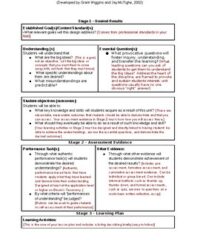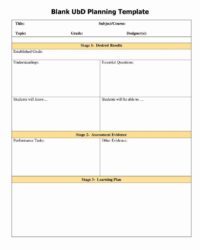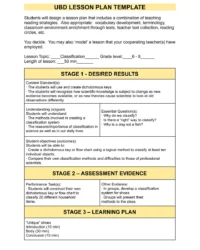Lesson planning can often feel like a monumental task, a detailed dance between curriculum requirements, student needs, and the ever-present clock. Many educators find themselves grappling with how to ensure their lessons are not just taught, but truly learned, with deep understanding at the core. It’s a common challenge to move beyond simply covering content to fostering genuine comprehension and transferable skills.
That’s where the Understanding by Design (UBD) framework steps in, offering a refreshing and highly effective approach. UBD isn’t just another planning method; it’s a philosophy that shifts the focus from what you’ll teach to what students will understand and be able to do. Imagine having a clear roadmap from the very start, ensuring every activity, every assessment, aligns perfectly with your ultimate learning goals. This method streamlines your planning, making it more purposeful and impactful, and finding a practical tool like a free ubd lesson plan template can truly make all the difference.
Why Understanding by Design Transforms Your Classroom
Understanding by Design, or UBD, is a highly regarded educational framework developed by Grant Wiggins and Jay McTighe. At its heart, UBD champions what’s known as “backward design.” Instead of starting with activities or textbooks, you begin with the end in mind: What do you want students to truly understand and be able to accomplish? This fundamental shift ensures that every element of your teaching—from assessments to daily activities—is intentionally designed to achieve those clear, overarching learning goals. It moves beyond rote memorization, pushing for deep conceptual understanding and the ability to apply knowledge in new situations.
Implementing UBD helps educators cultivate more coherent and purposeful lessons. When you know precisely what understanding looks like, you can craft assessments that genuinely measure that understanding, not just surface-level recall. This clarity then informs your instructional strategies, ensuring that every minute of class time contributes to the desired outcomes. Students, in turn, benefit from this intentionality; they are more engaged because the purpose of their learning is clear, and they can see the relevance of what they are doing. It fosters a more active and reflective learning environment, where students are partners in their own educational journey.
The Three Stages of Backward Design
The UBD framework is structured around three interconnected stages, providing a logical flow for effective planning:
Stage 1: Identify Desired Results. This is where you pinpoint the enduring understandings, essential questions, and specific knowledge and skills students should acquire. What are the big ideas you want them to grasp, the things they’ll remember years from now? This stage ensures your curriculum is focused and meaningful.
Stage 2: Determine Acceptable Evidence. Here, you design your assessments. Before you even think about teaching, you decide how you will know if students have achieved the desired results. This includes both formal and informal assessments, performance tasks, and authentic demonstrations of understanding. This stage is crucial for ensuring alignment between what you teach and how you measure learning.
Stage 3: Plan Learning Experiences and Instruction. Only after stages one and two are clear do you plan the actual lessons, activities, and instructional strategies. This stage involves selecting teaching methods and resources that will best help students achieve the identified understandings and prepare for the assessments. This ensures that every activity serves a purpose in the larger learning journey.
Key Benefits of Applying UBD
The advantages of adopting the UBD framework extend far beyond simply organizing your lesson plans. It fosters a deeper level of teaching and learning. Teachers experience increased clarity and confidence, knowing exactly what they are aiming for and why. This precision allows for more effective differentiation and targeted support for students. For students, UBD promotes deeper engagement and motivation, as they understand the “why” behind their learning, leading to more meaningful and lasting retention of concepts. It also helps them develop critical thinking skills as they grapple with essential questions and apply their knowledge.
Accessing and Utilizing Your Free Ubd Lesson Plan Template
Now that you appreciate the transformative power of UBD, the next logical step is to put it into practice, and a free ubd lesson plan template is an excellent starting point. There are numerous resources available online that offer pre-designed templates, often in formats that are easy to download and customize. When searching, look for templates that clearly delineate the three stages of backward design: desired results, acceptable evidence, and learning experiences. A good template will also provide space for essential questions, enduring understandings, and specific learning objectives, helping you to systematically plan each component of your unit or lesson.
Once you’ve found a template that suits your needs, the key is to make it your own. Don’t feel constrained by the boxes; they are there to guide your thinking, not limit it. Adapt the template to fit your subject matter, your grade level, and your unique teaching style. You might want to add sections for differentiation strategies, technology integration, or reflections on student performance. The beauty of a template is that it provides a foundational structure, freeing you up to focus on the content and pedagogical decisions rather than the formatting. It’s a living document that evolves with your teaching and your students’ needs.
Effectively utilizing your new template involves more than just filling it out; it’s about engaging with the UBD process thoughtfully. Start by brainstorming the big ideas and essential questions for your unit. What do you want students to understand at a deep level? What questions will spark their curiosity and guide their inquiry? Then, consider what evidence would demonstrate that understanding. How will students show you what they know and can do? Only then should you design the specific learning activities that will help them reach those goals. This systematic approach, facilitated by a well-designed free ubd lesson plan template, ensures that your lessons are always purposeful, coherent, and geared towards genuine student understanding.
Embracing the Understanding by Design framework, especially with the practical assistance of a readily available template, can revolutionize your approach to teaching. It provides a clear, logical pathway to designing instruction that is deeply effective and genuinely student-centered. You’ll find yourself planning with greater clarity and confidence, knowing that every step is purposeful and aligned with meaningful learning outcomes.
The journey to fostering deeper understanding in your students begins with intentional design. By leveraging the principles of UBD and making good use of a structured planning tool, you’re not just creating lessons; you’re crafting powerful learning experiences that stick. It’s about moving from simply covering content to uncovering enduring understanding, empowering your students for long-term success.


